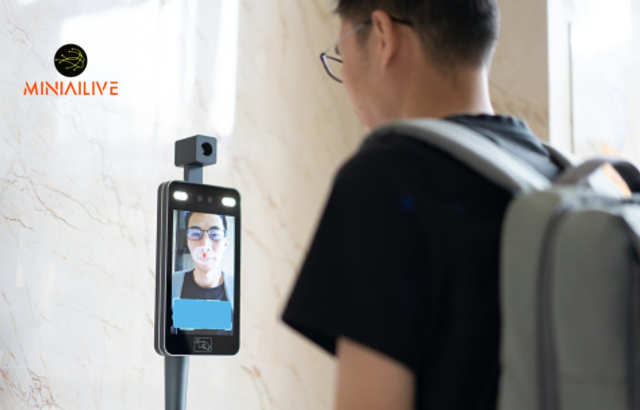Exploring the Benefits of Mobile Face Recognition in Everyday Life Once confined to the realms of science fiction, mobile face recognition technology is now seamlessly integrated into our daily activities, particularly through smartphones and other mobile devices. With the increasing availability of face unlocking features on mobile devices, users can conveniently bypass traditional password or PIN login methods. While this innovative technology is still relatively new and requires further consideration regarding privacy and security risks, its potential benefits have the capability to revolutionize our interactions with mobile devices on a day-to-day basis.
What is Mobile Face Recognition?
Mobile face recognition is an advanced biometric technology that uses a mobile device’s camera to identify individuals by analyzing unique facial features, creating a distinct facial signature. This signature is compared to a database of images for verification. Its widespread use enhances security, streamlines authentication, and improves user experiences, potentially transforming interactions with technology in daily life.
Technology and Algorithm Behind Mobile Face Recognition by MiniAI
| Technology/Algorithm | Description | Technology Used |
|---|---|---|
| Image Capture | The process of capturing an image of the user's face using the mobile device's camera. | * Digital cameras (RGB and infrared) |
| Preprocessing | The captured image is prepared for analysis. | * Image processing libraries (e.g., OpenCV, Pillow) * Computer vision techniques |
| Feature Extraction | Key facial features are extracted from the preprocessed image. | * Classic algorithms (LBPH, Fisherfaces, Eigenfaces) * Deep learning models (CNNs like VGG-Face, FaceNet) |
| Facial Representation | The extracted features are converted into a compact mathematical representation. | * Mathematical encoding techniques |
| Matching | The faceprint is compared against a database of stored facial templates. | * Distance metrics (Euclidean, Cosine) * Classification algorithms (e.g., SVM, KNN) |
| Decision | A threshold is used to determine if there's a match. | * Statistical decision-making |
| Deep Learning (CNNs) | Deep learning models can perform multiple steps at once. | * Frameworks like TensorFlow, PyTorch |
| Anti-spoofing (Liveness Detection) | Techniques to prevent spoofing attempts. | * Image analysis * Behavioral analysis (blink detection) * Hardware sensors (light sensing) |
| 3D Face Modeling | 3D face models provide greater accuracy. | * Structured light sensors * Depth cameras |
| Security and Encryption | Protecting sensitive biometric data. | * Encryption algorithms (e.g., AES) * Secure storage mechanisms (hardware security modules, trusted execution environments) |
Importance and Need of MiniAI Face Recognition Technology in Modern Era
| Importance/Need | Description | Examples |
|---|---|---|
| Seamless Unlocking | Bypass cumbersome passwords or patterns for quick and easy access to mobile devices. | Unlocking your smartphone with a glance. |
| Effortless Payments | Authorize purchases and transactions without the need for cards or PINs. | Paying for groceries with your face at the checkout. |
| Robust Security | Provide a strong layer of authentication that's harder to compromise than traditional methods. | Protecting sensitive data on your phone or controlling access to restricted areas. |
| Fraud Prevention | Mitigate identity theft and unauthorized financial transactions. | Banking apps using facial recognition to confirm transactions. |
| Streamlined Access Control | Grant access to buildings, rooms, or sensitive information only to authorized individuals. | Replacing keycards with facial recognition for office entry. |
| Frictionless Experiences | Eliminate the need to remember multiple passwords or navigate complex interfaces. | Logging into accounts and services with a single glance. |
| Accessibility Enhancement | Offer alternative authentication methods for users with disabilities or impairments. | Unlocking devices for users with limited dexterity or vision impairments. |
| Personalized Recommendations | Receive tailored suggestions for products, content, or services based on preferences. | Shopping apps using facial recognition to track browsing habits. |
| Law Enforcement Support | Assist in identifying suspects and persons of interest, aiding investigations. | Matching surveillance footage to databases of known individuals. |
| Healthcare Innovation | Streamline patient identification, remote monitoring, and potentially even pain assessment. | Verifying patient identity in hospitals, analyzing facial expressions for non-verbal communication. |
| Smart Home Control | Interact with smart appliances and devices using only your face. | Unlocking doors, adjusting lighting, or setting temperature with facial commands. |
| Efficient Identity Verification | Validate identity across various services and applications. | Onboarding processes for banking or online services. |
| Evolving Technology | AI-powered systems continuously learn and adapt, improving accuracy and robustness. | Adapt to changes in appearance, better detect spoofing attempts. |
| Addressing Privacy Concerns | Clear policies, data protection mechanisms, and user consent are crucial. | Transparent communication about data usage and strong security measures. |
| Mitigating Bias | Technology must strive for high accuracy across diverse demographics. | Algorithms trained on inclusive datasets to minimize unfair outcomes. |
Industry Wise Application Of Mini Ai Mobile Recognition Technology Exploring the Benefits of Mobile Face Recognition in Everyday Life Mobile face recognition is a biometric technology that utilizes advanced algorithms and a device’s camera to detect and verify individuals by analyzing their unique facial features. By mapping the facial geometry, such as the distances between eyes, the width of the nose, and the shape of the cheekbones, this technology creates a distinct facial signature. This signature is then compared to a database of stored facial images to identify potential matches. Mobile face recognition technology offers numerous benefits in everyday life. Firstly, it enhances the security of mobile devices by providing an additional layer of authentication. With facial recognition, users can securely unlock their devices, access sensitive information, and authorize transactions with a simple glance, reducing the reliance on traditional passwords or PINs. Furthermore, mobile face recognition technology enables seamless and personalized user experiences. By analyzing facial expressions and emotions, applications can adapt and respond in real-time, tailoring content and services to individual preferences. This not only improves user satisfaction but also opens up new possibilities for personalized marketing and targeted advertising. In the realm of law enforcement and public safety, mobile face recognition plays a crucial role. It aids in the quick and accurate identification of individuals, helping law enforcement agencies prevent and solve crimes more efficiently. By comparing the facial signatures of suspects with vast databases of known criminals, mobile face recognition technology can assist in locating wanted individuals or identifying missing persons. Moreover, mobile face recognition has significant applications in the healthcare industry. It can facilitate patient identification and authentication, ensuring accurate and secure access to medical records. This technology also enables healthcare providers to track and monitor patients, verify medication administration, and enhance overall patient safety. Beyond security and healthcare, mobile face recognition technology holds promise in various other sectors. For instance, in the transportation industry, it can expedite airport security checks and improve passenger boarding processes, enhancing both efficiency and safety. Additionally, in the retail sector, mobile face recognition can enable personalized shopping experiences, offering customized recommendations and streamlining the payment process. In conclusion, mobile face recognition technology is revolutionizing various aspects of everyday life. From enhancing device security to enabling personalized user experiences, from aiding law enforcement to improving healthcare practices, its applications are wide-ranging and impactful. As this technology continues to advance, we can expect even greater integration and utilization in multiple industries, unlocking new possibilities and redefining the way we interact with our mobile devices and the world around us.
| Industry | Application Examples |
|---|---|
| Security & Surveillance | * Access control to buildings, restricted areas, or devices. * Law enforcement suspect identification and tracking. * Crowd monitoring and security at events and public spaces. |
| Finance & Banking | * Secure transaction authorization. * Customer identification and onboarding. * Fraud prevention and detection. |
| Healthcare | * Patient identification and record management. * Remote patient monitoring and pain assessment. * Access control to sensitive areas and medical data. |
| Retail & Marketing | * Personalized product recommendations. * Targeted advertising based on demographics. * Customer behavior analysis and foot traffic tracking. |
| Smart Homes & IoT | * Device unlocking and access control. * User authentication for personalized settings. * Interaction with smart appliances and systems. |
| Travel & Transportation | * Automated check-ins and boarding processes. * Baggage claim and identity verification. * Security checkpoints and passenger monitoring. |
| Education | * Student attendance tracking. * Personalized learning experiences. * Secure access to online resources and exams. |
| Entertainment | * Avatar creation and personalization in games and virtual environments. * Interactive experiences tailored to the user. * Age verification for content access. |
| Government Services | * Secure citizen identification and document verification. * Streamlined access to government services and benefits. * Border control and immigration processes. |
| Workplace | * Employee time and attendance tracking. * Secure access to company resources and data. * Authentication for sensitive operations. |
Advantages of Mini AI Mobile Face Recognition over other face recognition technologies
| Feature | Mini AI Mobile Face Recognition | Other Face Recognition Technologies |
|---|---|---|
| Convenience | Designed specifically for mobile devices, offering effortless integration and a seamless user experience. | Require specialized hardware or setups, potentially less convenient for mobile applications. |
| Scalability | Cloud-based solutions and lightweight algorithms provide scalability for businesses of all sizes. | Some traditional systems may have higher infrastructure costs or limitations for large-scale deployments. |
| Speed | Optimized for real-time processing and quick responses on mobile devices. | Slower, especially with resource-intensive algorithms or on less powerful hardware. |
| Accessibility | Leverages existing smartphone cameras making it widely accessible. | Necessitate dedicated cameras or additional hardware, increasing costs. |
| Liveness Detection | Advanced anti-spoofing measures to prevent fraud attempts using photos or videos. | Lack robust liveness detection, raising security vulnerabilities. |
| Adaptability | AI-powered systems continuously improve accuracy and robustness over time. | May not benefit from the same level of self-learning and optimization. |
| Customization | Can be tailored for specific business needs and use cases, offering flexibility. | Less flexibility with pre-built solutions or limited customization options. |
| Cost-effectiveness | Leverages existing mobile infrastructure and offers cloud-based solutions for affordability. | Involve higher costs for hardware, setup, and maintenance. |
Conclusion
From enhancing phone security to enabling smart recommendations and sleek entertainment, face recognition offers significant benefits to improve our mobile experiences. Careful consideration must be given to issues involving informed consent, data usage, potential bias and fairness as this technology becomes more widespread and integrated into daily life.

















